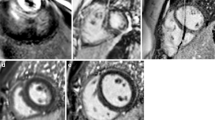Abstract
Background
Current protocols to determine optimal nulling time in late enhancement imaging using adult techniques may not apply to children.
Objective
To determine the optimal nulling time in anesthetised children, with the hypothesis that this occurs earlier than in adults.
Materials and methods
Sedated cardiac MRI was performed in 12 children (median age: 12 months, range: 1–60 months). After gadolinium administration, scout images at 2, 3, 4 and 10 min and phase sensitive inversion recovery (PSIR) images from 5 to 10 min were obtained. Signal-to-noise ratio (SNR) and inversion time (TI) were determined. Quality of nulling was assessed according to a grading score by three observers. Data was analysed using linear regression, Kruskal-Wallis and quadratic-weighted kappa statistics.
Results
One child with a cardiomyopathy had late enhancement. Good agreement in nulling occurred for scout images at 2 (κ = 0.69) and 3 (κ = 0.66) min and moderate agreement at 4 min (κ = 0.57). Agreement of PSIR images was moderate at 7 min (κ = 0.44) and poor-fair at other times. There were significant correlations between TI and scout time (r = 0.61, P < 0.0001), and SNR and kappa (r = 0.22, P = 0.017).
Conclusion
Scout images at 2–4 min can be used to determine the TI with little variability. Image quality for PSIR images was highest at 7 min and SNR optimal at 7–9 min. TI increases with time and should be adjusted frequently during imaging. Thus, nulling times in children differ from nulling times in adults when using standard adult techniques.








Similar content being viewed by others
References
Flacke S, Allen JS, Chia JM et al (2003) Characterization of viable and nonviable myocardium at MR imaging: comparison of gadolinium-based extracellular and blood pool contrast materials versus manganese-based contrast materials in a rat myocardial infarction model. Radiology 226:731–738
Mahrholdt H, Wagner A, Judd RM et al (2002) Assessment of myocardial viability by cardiovascular magnetic resonance imaging. Eur Heart J 23:602–619
Elgeti T, Abdel-Aty H, Wagner M et al (2007) Assessment of late gadolinium enhancement in nonischemic cardiomyopathy: comparison of a fast Phase-Sensitive Inversion Recovery Sequence (PSIR) and a conventional segmented 2D gradient echo recall (GRE) sequence—preliminary finding. Invest Radiol 42:671–675
Ho CY, Lopez B, Coelho-Filho OR et al (2010) Myocardial fibrosis as an early manifestation of hypertrophic cardiomyopathy. N Engl J Med 363:552–563
Huber AM, Schoenberg SO, Hayes C et al (2005) Phase-sensitive inversion-recovery MR imaging in the detection of myocardial infarction. Radiology 237:854–860
Kellman P, Arai AE, McVeigh ER et al (2002) Phase-sensitive inversion recovery for detecting myocardial infarction using gadolinium-delayed hyperenhancement. Magn Reson Med 47:372–383
Setser RM, Chung YC, Weaver JA et al (2005) Effect of inversion time on delayed-enhancement magnetic resonance imaging with and without phase-sensitive reconstruction. J Magn Reson Imaging 21:650–655
Petersen SE, Mohrs OK, Horstick G et al (2004) Influence of contrast agent dose and image acquisition timing on the quantitative determination of nonviable myocardial tissue using delayed contrast-enhanced magnetic resonance imaging. J Cardiovasc Magn Reson 6:541–548
Simonetti OP, Cook S (2006) Technical aspects of pediatric CMR. J Cardiovasc Magn Reson 8:581–593
Wald RM, Haber I, Wald R et al (2009) Effects of regional dysfunction and late gadolinium enhancement on global right ventricular function and exercise capacity in patients with repaired tetralogy of Fallot. Circulation 119:1370–1377
Secinaro A, Ntsinjana H, Tann O et al (2011) Cardiovascular magnetic resonance findings in repaired anomalous left coronary artery to pulmonary artery connection (ALCAPA). J Cardiovasc Magn Reson 13:27
Voges I, Jerosch-Herold M, Hedderich J et al (2010) Maladaptive aortic properties in children after palliation of hypoplastic left heart syndrome assessed by cardiovascular magnetic resonance imaging. Circulation 122:1068–1076
Bartelink IH, Rademaker CM, Schobben AF et al (2006) Guidelines on paediatric dosing on the basis of developmental physiology and pharmacokinetic considerations. Clin Pharmacokinet 45:1077–1097
Cummings KW, Bhalla S, Javidan-Nejad C et al (2009) A pattern-based approach to assessment of delayed enhancement in nonischemic cardiomyopathy at MR imaging. Radiographics 29:89–103
Kim RJ, Shah DJ, Judd RM (2003) How we perform delayed enhancement imaging. J Cardiovasc Magn Reson 5:505–514
Constantinides CD, Atalar E, McVeigh ER (1997) Signal-to-noise measurements in magnitude images from NMR phased arrays. Magn Reson Med 38:852–857
Gupta A, Lee VS, Chung YC et al (2004) Myocardial infarction: optimization of inversion times at delayed contrast-enhanced MR imaging. Radiology 233:921–926
Kim RJ, Fieno DS, Parrish TB et al (1999) Relationship of MRI delayed contrast enhancement to irreversible injury, infarct age, and contractile function. Circulation 100:1992–2002
Oshinski JN, Yang Z, Jones JR et al (2001) Imaging time after Gd-DTPA injection is critical in using delayed enhancement to determine infarct size accurately with magnetic resonance imaging. Circulation 104:2838–2842
Eichstaedt HW, Felix R, Danne O et al (1989) Imaging of acute myocardial infarction by magnetic resonance tomography (MRT) using the paramagnetic relaxation substance gadolinium-DTPA. Cardiovasc Drugs Ther 3:779–788
Schwitter J, Saeed M, Wendland MF et al (1997) Influence of severity of myocardial injury on distribution of macromolecules: extravascular versus intravascular gadolinium-based magnetic resonance contrast agents. J Am Coll Cardiol 30:1086–1094
Baker JF, Kratz LC, Stevens GR et al (2004) Pharmacokinetics and safety of the MRI contrast agent gadoversetamide injection (Optimark) in healthy pediatric subjects. Invest Radiol 39:334–339
Dulce MC, Duerinckx AJ, Hartiala J et al (1993) MR imaging of the myocardium using nonionic contrast medium: signal-intensity changes in patients with subacute myocardial infarction. AJR 160:963–970
Kim RJ, Chen EL, Lima JA et al (1996) Myocardial Gd-DTPA kinetics determine MRI contrast enhancement and reflect the extent and severity of myocardial injury after acute reperfused infarction. Circulation 94:3318–3326
Klein C, Nekolla SG, Balbach T et al (2004) The influence of myocardial blood flow and volume of distribution on late Gd-DTPA kinetics in ischemic heart failure. J Magn Reson Imaging 20:588–593
Author information
Authors and Affiliations
Corresponding author
Rights and permissions
About this article
Cite this article
Tham, E.B., Hung, R.W., Myers, K.A. et al. Optimization of myocardial nulling in pediatric cardiac MRI. Pediatr Radiol 42, 431–439 (2012). https://doi.org/10.1007/s00247-011-2276-z
Received:
Revised:
Accepted:
Published:
Issue Date:
DOI: https://doi.org/10.1007/s00247-011-2276-z




